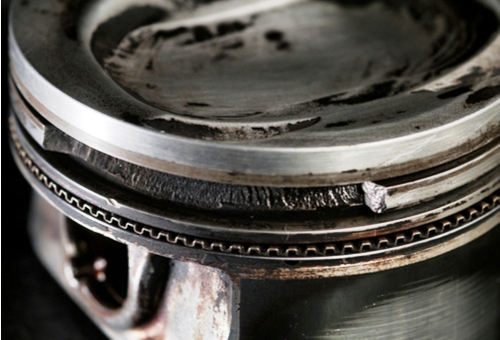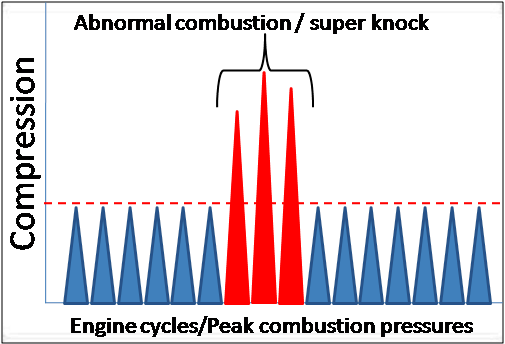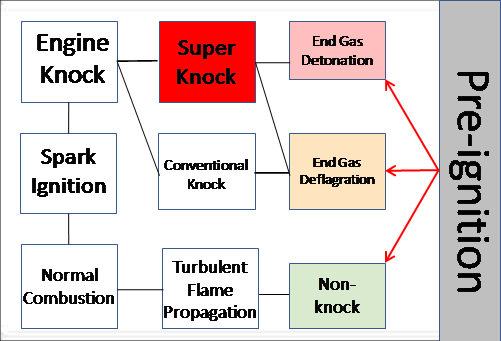
We have all encountered pre-ignition on petrol engines, but how well do we know and understand the phenomenon of super knock, a similar, but vastly more violent form of uncontrolled combustion that has the potential to break spark plugs and pistons, melt exhaust valves, and even bend and break connecting rods? This week, we take a closer look at the phenomenon of super knock, a destructive, anomalous combustion process that has seen a sharp rise with the advent of small-displacement, forced induction petrol engines. Let us start with this question-
While pre-ignition and super knock both occur when the air/fuel mixture is ignited by a source of heat other than the ignition spark during high load, low engine speed conditions, the exact causes and progression of pre-ignition are only marginally better understood than the causes of super knock. Nonetheless, while the causes of pre-ignition are stochastic* in nature, most engineers and engine designers accept that for the most part, pre-ignition is most commonly induced by the following mechanisms-
*”Stochastic” or random processes can be defined as processes that depend on a collection of randomly variable conditions being present before a process can occur. In practice though, each variable has the potential to influence the outcome of the process, so as this relates to combustion, the number, size, and temperature of carbon hotspots in a cylinder would represent one such variable. Other variables include the condition of spark plugs that deteriorate over time, and intake airflow dynamics that change with engine speed, etc.
Surface ignition
This refers to a condition where the air/fuel mixture is ignited by either a glowing spot of carbon on the piston or in the combustion chamber, or by extremely hot metal surfaces within the cylinder, such as might occur when an engine is running significantly hotter than normal. However, whether or not pre-ignition occurs as the result of surface ignition on any given engine is dependent on engine characteristics such as its mechanical condition, and the quality of both the fuel and lubricating oil.
Excessive amounts of oil in cylinders
While excessive amounts of oil cause carbon deposits that could create one or more local hot spots within a cylinder, pre-ignition could also be induced when liquid oil mixes with the air/fuel mixture during the early stages of compression. Depending on the dynamics of the airflow during the compression stroke it could also happen that the added volume of oil in the air/fuel mixture raises the compression pressure to far above normal, in which case the mixture may be ignited prematurely at multiple points throughout the mixture, in much the same way that a diesel/air fuel mixture ignites.
It should be noted though that in cases where pre-ignition does not result from surface ignition due to carbon hotspots, the average peak combustion pressures during pre-ignition cycles is significantly higher than pressures resulting from any other cause. Note also that less-common causes of pre-ignition include impingement of even marginally premature fuel spray patterns on cavities in piston crowns, intake charge stratification during compression, and cylinder wall wetting as the result of poor injection spray patterns or the presence of excess oil.
As a practical matter, all of the mechanisms listed above can induce pre-ignition independently of ignition timing settings. In translation, this means that if conditions are suitable for pre-ignition to occur, conventional knock control strategies via the knock sensor(s) will generally not eliminate or reduce the incidence of pre-ignition combustion cycles if the relationship between engine speed and load remains unchanged, which begs this question-

This diagram is illustrative of super knock, and it shows an approximation of the combustion pressure differences that can occur between normal combustion (Indicated by the red dotted line) and combustion during super knock events. Note that the pressure oscillation between the two combustion modes can exceed 300% of normal combustion pressure.
In practice though, the term “super knock” is a generic reference to several principal types of engine knock that are characterised by the facts that a), combustion pressures are higher than those occurring during pre-ignition, and b), all forms of super knock have the potential to damage an engine.
As a practical matter, these forms of engine knock are known as end-gas* deflagration**, which is further divided into heavy-knock, slight-knock, and turbulent flame propagation that does not always (or necessarily) produce engine knock, and end-gas detonation***, which is referred to as super knock.
*End-gas is the last part of the intake charge to enter the combustion chamber, and usually the last part of the intake charge to be ignited
**Deflagration occurs when the combustion flame/process propagates outward from the source of ignition at speeds below that of sound (sub-sonic)
***Detonation occurs when the combustion flame/process propagates outward from the source of ignition at speeds above that of sound (supersonic)
While the above is very interesting, it does not explain the mechanisms that initiate and drive super knock events, so in the following section, we will take a closer look at-

Consider the diagram above, which shows the relationships between the various forms of super knock that occurs at low engine speeds and loads. It is worth noting however, that while pre-ignition is the primary initiator of super knock, super knock does not always (or necessarily) result from pre-ignition. Similarly, pre-ignition also does not necessarily result in audible engine knock; in some cases, pre-ignition may be present but not in a severe-enough form to disrupt the combustion process sufficiently to produce audible symptoms.
While pre-ignition is for all practical purposes constant for as long as the current engine operating conditions allow it to occur, super knock happens randomly, and for the most part, without a direct correlation to engine control parameters such as ignition timing settings, air/fuel ratios, and coolant/engine temperature. Therefore, because of the stochastic nature of the causes of super knock, the phenomenon is now the single biggest obstacle in efforts to improve the power density of forced induction petrol engines.
Nonetheless, before we get to the mechanics of super knock, it is important to mention the fact that exhaustive testing and experimentation by both car manufacturers and independent researchers have shown that auto-ignition (pre-ignition and all forms of super knock) of air/fuel mixtures in petrol engines can be divided into four modes, these being-
Having said the above, let us look at the least harmful form of super knock first, this form being-
Deflagration knock
There is no single set of conditions that would define or characterize deflagration knock, since its intensity varies from engine to engine. However, what distinguishes it from detonation knock is the fact that combustion pressures during deflagration knock are significantly lower than in detonation knock. More to the point though, the manner in which the combustion flame propagates through the air/fuel mixture is largely similar to how it happens in “normal” pre-ignition, but with the difference that in some cases, the deflagration of the end gas can reinforce the abnormal combustion process that occurs during pre-ignition. Note though that pre-ignition is required for deflagration knock to occur.
Detonation knock
This form of knock is the most harmful, and although the exact conditions (except for the presence of pre-ignition) that must prevail for it to occur are not clearly defined or well understood, extensive experimentation has revealed that detonation knock can only occur if the flowing three conditions are met-
1) Pre-ignition must be occurring
2) The pressure and temperature of the end gas must be high enough to trigger the auto-ignition of the end gas
3) There must be a local hot spot (other than the ignition spark) in the cylinder that is hot enough to ignite the end gas
NOTE: Conditions 2 & 3 are not the same. In condition 2 it is possible for the end gas to ignite spontaneously as a result of adiabatic heating of the end gas combining with high surface temperatures of pistons and exhaust valves. Condition 3 refers specifically to hot spots created by either carbon deposits, or the presence of excessive quantities of oil in the cylinders.
Nonetheless, below is a description of a hypothetical case of detonation knock-
If conditions are suitable, pre-ignition occurs well before TDC as the result of one of the conditions listed above. The local release of heat energy then initiates a flame front that propagates from the site of the hotspot throughout the rest of the intake charge until spark ignition of the unburned portion of the intake charge occurs.
Depending on the unburned fraction of the intake charge, the two forms of ignition creates what amounts to two competing detonation flame fronts that cause an extremely rapid rise in both pressure and temperature in the cylinder. Both pressure and temperature are further increased when the end gas is ignited either by the adiabatic heating of the partially combusted mixture by the upward motion of the piston, or by a secondary hotspot, such as might be created during pre-ignition. Note that typical in-cylinder temperatures and pressures under detonation knock conditions can exceed 1000 K (720+ deg C), and 20 million Pascal respectively, which brings us to the subject of-
It should be noted that two opposing combustion flame fronts coupled with a rapid rise in in-cylinder temperatures create two shock waves that expand rapidly* outwards from the source(s) of ignition towards the cylinder walls, which further increases the in-cylinder temperature when the two shock waves are reflected off the cylinder walls.
*The typical velocity sound in an uncombusted petrol/air mixture is about 701 metres per second, while the typical velocity of super knock pressure waves is about 1800 metres per second.
In fact, if the spark plug is mounted in the centre of the cylinder, it often happens that the two reflected shock waves meet at the spark plug with enough force to both break the side contact off the threaded part of the spark plug, and to shatter the ceramic sleeve around the centre electrode. Since these fragments often get trapped between the exhaust valve and the valve seat, thus preventing the valve from closing, the super heated exhaust gas can, and often does, melt the exhaust valve when it exits through the leak path.
While pistons rarely melt under super knock conditions, in-cylinder pressures of up to 20 million Pascal represent what amounts to a solid surface into which the pistons slam in their upward motion in much the same way that your wind is knocked out when you do a belly flop into a swimming pool. In the case of pistons, the force of the collision almost invariably causes the first ring land to break or fragment, which in turn, also almost invariably causes the two compression rings to break or shatter. In addition, but depending on how many degrees of crankshaft rotation before TDC the super knock event occurs, it could also happen that connecting rods bend, break, or shatter when they encounter the pressure peak.
It should be noted though that the ultimate in-cylinder pressure during a super knock event largely depends on the volume of the unburned fraction of the intake charge when spark ignition occurs. While unburned fractions of less than about 8% rarely cause serious engine damage, experimentation has shown that fatal engine damage is almost inevitable when unburned fractions approach or exceed about 50% when spark ignition occurs, which leaves us with this question-
The short answer seems to be “No”, since all forms of super knock is a natural, albeit hugely undesirable consequence of the ongoing trend to squeeze ever more power out of engines that are getting progressively smaller in terms of displacement.
One possible solution that has been suggested could involve disabling the fuel injectors on cylinders that exhibit pre-ignition, which would have the effect of momentarily starving the abnormal combustion process of fuel. However, in practice, this measure could conceivably produce serious and potentially dangerous power losses at the exact moment maximum engine power is needed, which is likely why this strategy has not been implemented.
One other possible solution could be the widespread adoption of HCCI (Homogenous Charge Compression Ignition). While Mazda has shown that the technology works, making it work on small-displacement engines involves overcoming huge engineering challenges relating to combustion phase control, developing homogenous charge preparation strategies/systems, and developing control systems to prevent auto-ignition progressing into detonation of the end gas. On small-displacement engines, this is particularly difficult since the reasons why pre-ignition sometimes progresses to detonation knock cannot (as yet) be ascribed to any single cause or set of circumstances, except to say that it most commonly occurs when engine speeds are low and engine loads are high.
As a practical matter however, HCCI combustion only works in a very narrow operating range, which means that the combustion process outside of this narrow range still depends on conventional spark ignition, which leaves us with this-
From an engineering perspective, it seems as if the development of small-displacement engines in terms of increasing their power density has reached a peak, or at least a plateau. Future advancements in this area will likely include the development of combustion stabilizers, and/or control mechanisms to starve abnormal combustion processes of fuel, and/or of the in-cylinder pressure gradient that now demarcates the transition from pre-ignition to all forms of super knock.
How well these measures will work (if they can be made to work at all) remains to be seen, but chances are that advances in electric vehicle technologies will soon outpace the need for highly stressed, small displacement petrol engines as the primary source of motive power in the next generation of vehicles.